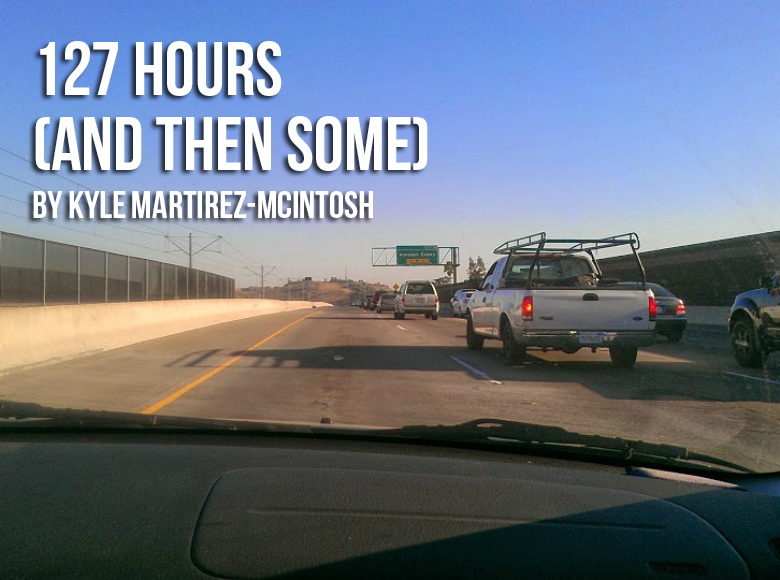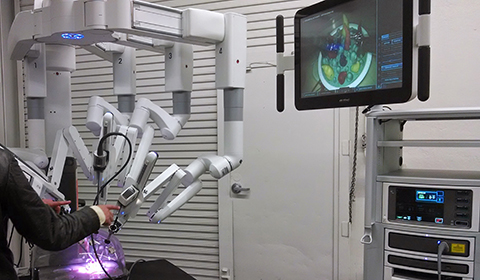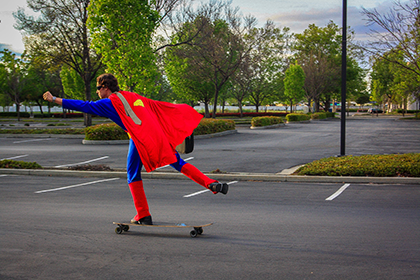At some point, everyone takes a road trip. Sometimes, it’ll be something indulgent and last minute, like the time I got dragged to Vegas on two hours notice and had to sleep in the lobby once we got there, while my friend was in our hotel room with a hooker on Easter morning. Or it’ll be poorly planned, like last Valentine’s Day when a drive up the coast ended pulled over and huddled in a tent during a 40-degree rainstorm. But I think, to truly qualify as a “road trip story,” the story has to focus on what happens on the road rather than at the ultimate destination. In that case, there’s only one road trip story I know.
In the winter of 2009, I was preparing to move from New York to Los Angeles after landing my first job out of college. As with any entry-level job, the pay wasn’t very much, nor did it come with any relocation money. Seeing the predicament I was in, my dad came to me with an idea: road trip. He offered to rent an SUV and drive me across the country for some family bonding with him and my sister as I moved to LA for the then-foreseeable future.
The plan didn’t exactly thrill me. But, understanding my reaction requires a little background on where I come from: my parents have lived in different cities since I was five, making me very independent; I don’t like tight spaces, particularly with company; and I don’t talk to my family that much. Add in the fact that my dad scheduled enough stops to stretch the drive to nine days, and clearly this trip went against every survival instinct I have.
Going into the trip with a relatively fatalistic attitude, I figured my one chance at maintaining sanity would be to document the entire experience on video. What initially seemed like a fun way to kill time in the car and keep my friends abreast of my progress soon devolved into my dad nicknaming himself “YOM” (an acronym meaning “Your Old Man”) and my sister commandeering the camera to give shout-outs to my ex-girlfriends.
https://www.youtube.com/watch?v=EzCqWX0qUho
Things degraded further when we passed through Columbia, Missouri, home to my father’s alma mater, where he serenaded greater Missouri with his college fight song. A jaunt through Frat Row brought the introduction of the term “wench’s lost and found” turning the trip into Norman Rockwell’s worst nightmare set against the plot structure of Heart of Darkness.
Another unforeseen complication of sharing the car with my dad and a girl seven years my junior, was music choice. My dad had settled into the typical middle-aged obsession with John Mellencamp, Fleetwood Mac and Billy Joel (because the minute you hit fifty, those artists somehow become palatable), while Rachel would routinely snap on a pair of headphones and belt out top 40 hits in the backseat.
Agreeing on what to listen to is one of those things that starts out as a minor quibble, but after five days of listening to the same CDs on repeat (our rental car didn’t have an iPod dock) I was not-so-secretly considering stabbing my own eardrums to avoid hearing “Jack and Diane” for the 753rd time.
While much of the road trip was obviously spent, well, on the road, we interspersed a few visits to family across the country. An additional oddity of my family is how well everyone gets along. On the surface, that sounds like a banal statement, but when you consider that my parents have each been married three times, and literally everyone gets along, the strangeness comes to the fore. In Chicago, we stayed with the sister of my dad’s third wife; in St. Louis, with the parents of my mother (my dad’s first wife); in Kansas City, with my aunt; and closed the trip by having a guys’ weekend in Vegas with me, my dad, and my mom’s third husband. Throw in the fact that my dad gleefully recounted the story of my birth before an audience, and my seven years in therapy starts to make a lot more sense.
https://www.youtube.com/watch?v=ncZPrJo0IhY
Even though we had planned out some of our pit stops ahead of time, the first night of the trip proved just how little forethought had gone into the rest of the drive. We pulled into State College, PA, home of Penn State, during a blizzard, the day before winter graduation and on the same weekend as the statewide high school wrestling finals. In short, we couldn’t find a hotel room to save our lives. Little did I know this would become a recurring theme for the rest of the drive.
Later, at the halfway point of the trip, we ran out of gas because my dad ignored the low fuel warning. And we had the same problem again in a particularly desolate stretch of Utah where there isn’t a gas station or cell service for over 100 miles… In both instances, we had to depend on our hitchhiking abilities to get us to and from the nearest town with a can of fuel.
https://www.youtube.com/watch?v=ZWgRUh8LmjA
After the Utah incident, the trip got a lot smoother, thanks to the milder winters out west. By January of 2010, I was settled into a new apartment in Los Angeles, downright blissful in the belief that I’d never have to take on such a daunting move again, not realizing realize that I’d bounce between coasts again in 2011, 2012 and 2013, taking on the drive by myself each time.
And while driving cross-country by myself didn’t produce as many stories, at least I got to pick the music.

Photo by Sara Slattery







